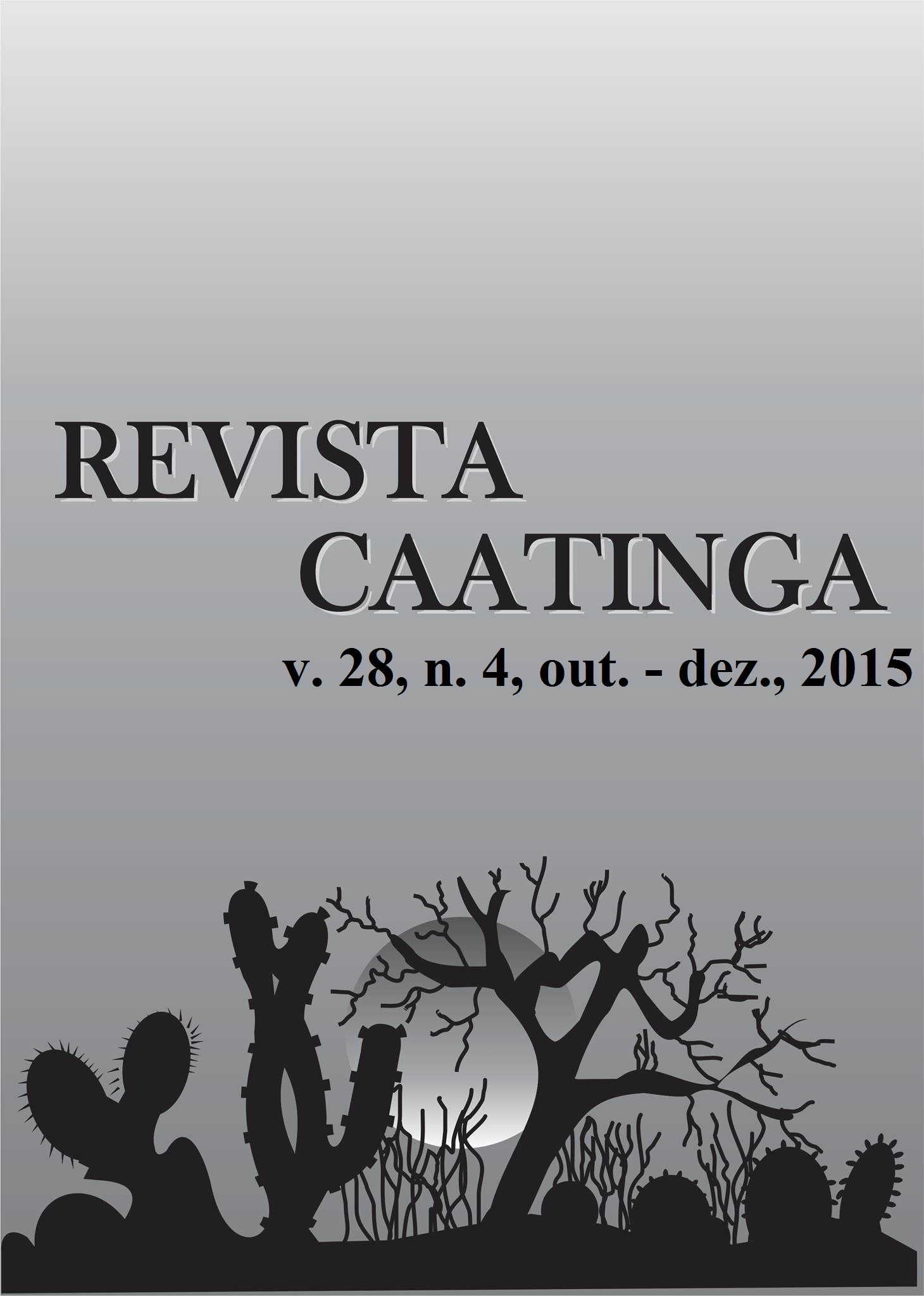EFFECT OF IRRIGATION ON YIELD AND FIBER QUALITY IN COTTON CULTIVARS
DOI:
https://doi.org/10.1590/1983-21252015v28n405rcKeywords:
Water deficit. Cotton. Semiarid.Abstract
This study was conducted to evaluate seed cotton yield, fiber yield, and fiber quality traits of cotton cultivars grown under different irrigation levels in Brazil. The experiment was conducted over two years in the region of Apodi – RN, with sprinkler irrigation. Treatments comprised of 4 irrigation levels i.e., 130, 100, 70 and 40 % of the crop evapotranspiration (ETc) and 4 cotton cultivars i.e., FiberMax 993, BRS 286, BRS 336 and BRS 335. The experimental design was factorial with randomized complete block design and four replicates. Yield, lint percent and fiber quality traits determined were evaluated. Different responses were observed for cultivars at various irrigation levels. Cultivars grown under limited irrigation exhibited a decline in the seed cotton yield, lint percent, and fiber quality. Cultivars with the highest yield and lint percent were FiberMax 993 and BRS 286. Within irrigation level of 40 % ETc, the medium fiber cultivars produced short fibers whereas the long fiber cultivar, BRS 336, produced medium fiber length. Overall, the different levels of water deficits did not significantly affect fiber quality of the four cultivars tested as all fiber quality traits remained acceptable for the domestic textile industry.Downloads
References
BALKCOM, K. S. et al. Cotton yield and fiber quality from irrigated tillage systems in the Tennessee Valley. Agronomy Journal, Madson, v. 98, n. 3, p. 596-602, 2006.
BASAL, H. et al. Effects of Deficit Drip Irrigation Ratios on Cotton (Gossypium hirsutum L.) Yield and Fiber Quality. Journal of Agronomy and Crop Science, Berlin, v. 195, n. 1, p. 19-29, 2009.
BOOKER, J. D. et al. Variable rate irrigation on cotton lint yield and fiber quality. In: BELTWIDE COTTON CONFERENCES, 2006, San Antonio. Anais… San Antonio: The Cotton Foundation, 2006. p. 1768-1776.
BRADOW, J. M.; DAVIDONIS, G. H. Quantitation of fiber quality and the cotton production-processing interface: a physiologist’s perspective. The Journal of Cotton Science, Baton Rouge, v. 4, n. 1, p. 34-64, 2000.
BRITO, G. G. et al. Physiological traits for drought phenotyping in cotton. Acta Scientiarum Agronomy, Maringá, v. 33, n. 1, p. 117-125, 2011.
CONAB. Companhia Nacional de Abastecimento. Acompanhamento da Safra Brasileira: Grãos. Décimo Segundo Levantamento, Setembro - 2013. Disponível em: <http://www.conab.gov.br>. Acesso em: 13 mar. 2014.
CRUZ, C. D.; CARNEIRO, P. C. S. Modelos biométricos aplicados ao melhoramento genético. 2. ed. Viçosa, MG: UFV, 2003. 585 p.
DAGDELEN, N. et al. Water-yield relation and water use efficiency of cotton (Gossypium hirsutum L.) and second crop corn (Zea mays L.) in western Turkey. Agricultural Water Management, Amsterdam, v. 82, n. 1, p. 63-85, 2006.
DAGDELEN, N. et al. Different drip irrigation regimes affect cotton yield, water use efficiency and fiber quality in western Turkey. Agricultural Water Management, Amsterdam, v. 96, n. 1, p. 111-120, 2009.
DE TAR, W. R. Yield and growth characteristics for cotton under various irrigation regimes on sandy soil. Agricultural water management, Amsterdam, v. 95, n. 1, p. 69-76, 2008.
SUI, R. et al. Effect of supplemental irrigation and graded levels of nitrogen on cotton yield and quality. Journal of Agricultural Science, Toronto, v. 6, n. 2, p. 119-131, 2014.
FALKENBERG, N. R. et al. Remote sensing of biotic and abiotic stress for irrigation management of cotton. Agricultural Water Management, Amsterdam, v. 87, n. 1, p. 23-31, 2007.
JOHNSON, R. M. et al. Variability in cotton fiber yield, fiber quality, and soil properties in a southeastern coastal plain. Agronomy Journal, Madson, v. 94, n. 6, p. 1305-1316, 2002.
MENG, Z. et al. Effect of regulated deficit irrigation on growth and development characteristics in cotton and its yield and fiber quality. Cotton Science, Henan, v. 20, n. 1, p. 39-44, 2008.
ONDER, D. et al. Effect of different irrigation water level on cotton yield and yield components. African Journal of Biotechnology, Lagos, v. 8, n. 8, p. 1536-1544, 2009.
PETTIGREW, W. T. Moisture deficit effects on cotton lint yield, yield components, and boll distribution. Agronomy Journal, Madson, v. 96, n. 2, p. 377-383, 2004.
RITCHIE, G. L. et al. Cotton growth and development. Georgia: CAES-UGA, 2004. 16 p. (Boletim 1252).
SANTANA, J. C. F. et al. Características da fibra e do fio do algodão. In: BELTRÃO, N. E. M.; AZEVEDO, D. M. P. (Ed.). O agronegócio do algodão no Brasil. Brasília: Embrapa Informação Tecnológica, 2008. v.2, cap. 31, p. 1099-1120.
SNOWDEN, C.; RITCHIE, G.; THOMPSON, T. Water use efficiency and irrigation response of cotton cultivars on subsurface drip in west Texas. The Journal of Cotton Science, Baton Rouge, v. 17, n. 1, p. 1-9, 2013.
WEN, Y. et al. Lint yield, lint quality, and economic returns of cotton production under traditional and regulated deficit irrigation schemes in southwest Texas. The Journal of Cotton Science, Baton Rouge, v. 17, n. 1, p. 10-22, 2013.
Downloads
Published
Issue
Section
License
Os Autores que publicam na Revista Caatinga concordam com os seguintes termos:
a) Os Autores mantêm os direitos autorais e concedem à revista o direito de primeira publicação, com o trabalho simultaneamente licenciado sob a Licença Creative Commons do tipo atribuição CC-BY, para todo o conteúdo do periódico, exceto onde estiver identificado, que permite o compartilhamento do trabalho com reconhecimento da autoria e publicação inicial nesta revista, sem fins comerciais.
b) Os Autores têm autorização para distribuição não-exclusiva da versão do trabalho publicada nesta revista (ex.: publicar em repositório institucional ou como capítulo de livro), com reconhecimento de autoria e publicação inicial nesta revista.
c) Os Autores têm permissão e são estimulados a publicar e distribuir seu trabalho online (ex.: em repositórios institucionais ou na sua página pessoal) a qualquer ponto antes ou durante o processo editorial, já que isso pode gerar alterações produtivas, bem como aumentar o impacto e a citação do trabalho publicado (Veja O Efeito do Acesso Livre).







